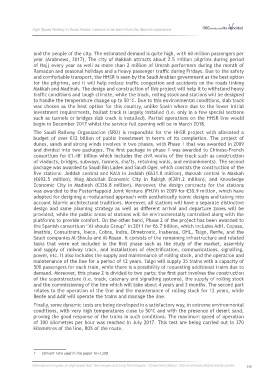Page 517 - 360.revista de Alta Velocidad - Nº 6
P. 517
High Speed Railway in Saudi Arabia: Lessons to be learnt from the Spanish experience
and the people of the city. The estimated demand is quite high, with 60 million passengers per
year (Arabnews, 2017). The city of Makkah attracts about 2.5 million pilgrims during period
of Hajj every year as well as more than 2 million of Umrah performers during the month of
Ramadan and seasonal holidays and a heavy passenger traffic during Fridays. Due to the safety
and comfortable transport, the HHSR is seen by the Saudi Arabian government as the best option
for the pilgrims, and it will help reduce traffic congestion and accidents on the roads linking
Makkah and Madinah. The design and construction of this project will help it to withstand heavy
traffic conditions and tough climate, while the track, rolling stock and stations will be designed
to handle the temperature change up to 50°C. Due to this environmental conditions, slab track
was chosen as the best option for this country, unlike Spain where due to the lower initial
investment requirements, ballast track is largely installed (i.e. only in a few special sections
such as tunnels or bridges slab track is installed). Partial operations on the HHSR line would
begin in December 2017 whilst the service full opening will be in March 2018.
The Saudi Railway Organization (SRO) is responsible for the HHSR project with allocated a
budget of over €12 billion of public investment in terms of its completion. The project of
dunes, sands and strong winds involves in two phases, with Phase 1 that was awarded in 2009
and divided into two packages. The first package in phase 1 was awarded to Chinese-French
consortium for €1.48 billion which includes the civil works of the track such as construction
1
of viaducts, bridges, subways, tunnels, shafts, retaining walls, and embankments). The second
package was awarded to Saudi Bin Laden and Saudi Oger, which consists the construction of the
five stations- Jeddah central and KAIA in Jeddah (€631.8 million), Makkah central in Makkah
(€692.5 million), King Abdullah Economic City in Rabigh (€381.2 million), and Knowledge
Economic City in Madinah (€336.8 million). Moreover, the design contracts for the stations
was awarded to the FosterHappold Joint Venture (FHJV) in 2009 for €30.9 million, which have
adopted for designing a modularised approach with aesthetically iconic designs and taking into
account Islamic architectural traditions. Moreover, all stations will have a separate distinctive
design and same planning strategy as well as different arrival and departure zones will be
provided, while the public areas of stations will be environmentally controlled along with the
platforms to provide comfort. On the other hand, Phase 2 of the project has been awarded to
the Spanish consortium “Al-shoula Group” in 2011 for €6.7 billion, which includes Adif, Copasa,
Imathia, Consultrans, Ineco, Cobra, Indra, Dimetronic, Inabensa, OHL, Talgo, Renfe, and the
Saudi companies Al-Shoula and Al-Rosan. It consists of the remaining infrastructure and related
tasks that were not included in the first phase such as the study of the market, assembly
and supply of railway track, and installations of electrification, communications, signalling,
power, etc. It also includes the supply and maintenance of rolling stock, and the operation and
maintenance of the line for a period of 12 years. Talgo will supply 35 trains with a capacity of
500 passengers for each train, while there is a possibility of requesting additional trains due to
demand. Moreover, this phase 2 is divided to two parts; the first part involves the construction
of the superstructure (i.e. track, catenary and signalling systems), the supply of rolling stock
and the commissioning of the line which will take about 4 years and 3 months. The second part
relates to the operation of the line and the maintenance of rolling stock for 12 years, while
Renfe and Adif will operate the trains and manage the line.
Finally, some dynamic tests are being developed in a satisfactory way, in extreme environmental
conditions, with very high temperatures close to 50°C and with the presence of desert sand,
proving the good response of the trains in such conditions. The maximum speed of operation
of 300 kilometres per hour was reached in July 2017. This test are being carried out in 370
kilometres of the line, 80% of the route.
1 Convert rate used in the paper 1€=1.22$
International Congress on High-speed Rail: Technologies and Long Term Impacts - Ciudad Real (Spain) - 25th anniversary Madrid-Sevilla corridor 515

